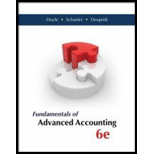
a.
Explain the way in which Company C initially determine the income to be reported in 2014 in connection with its ownership of Company M.
b.
Explain the factors which should have influenced Company C in its decision to apply the equity method in 2015.
c.
Explain the factors which could have prevented Company C from adopting the equity method after this second purchase.
d.
Identify the objective of the equity method of accounting.
e.
Identify the criticisms which have been levelled at the equity method.
f.
Explain the way in which Company C determines the income to be reported in 2014 in connection with its ownership of Company M and why is this accounting appropriate.
g.
Explain the way in which the allocation of Company C’s acquisition made.
h.
Explain if Company F declares a cash dividend, what impact does it have on Echo’s financial records under the equity method and why is this accounting appropriate.
i.
Explain what amounts are included in Company C’s Investment in Company M’s account and the amounts are included in Company C’s Equity in Income of Company M’s account.
Want to see the full answer?
Check out a sample textbook solution
Chapter 1 Solutions
Fundamentals of Advanced Accounting
- Please provide the solution to this general accounting question using proper accounting principles.arrow_forwardPlease provide the accurate answer to this financial accounting problem using appropriate methods.arrow_forwardI am searching for the accurate solution to this general accounting problem with the right approach.arrow_forward
- How much lower would kite net income be if it used variable costing instead of absorption costing ?arrow_forwardKepler Manufacturing has $18,000 of ending finished goods inventory as of December 31, 2023. If beginning finished goods inventory was $8,000 and the cost of goods sold (COGS) was $55,000, how much would Kepler report for cost of goods manufactured?arrow_forwardMosco Industries manufactures a single product and follows a JIT policy where ending inventory must equal 20% of the next month's sales. It estimates that November's ending inventory will consist of 32,000 units. December and January sales are estimated to be 210,000 and 225,000 units, respectively. Mosco assigns variable overhead at a rate of $2.85 per unit of production. Fixed overhead equals $375,000 per month. Compute the number of units to be produced and the total budgeted overhead that would appear on the factory overhead budget for the month of December.arrow_forward
- Can you explain this general accounting question using accurate calculation methods?arrow_forwardAnderson owns securities with a tax basis of $8,400. He gives them to Taylor when they are worth only $6,900. Taylor held these securities until they were worth $9,300 and sold them. What amount of gain does he have to report on this sale? a) $650 b) $400 c) $900 d) $1,100arrow_forwardCan you demonstrate the proper approach for solving this financial accounting question with valid techniques?arrow_forward

 AccountingAccountingISBN:9781337272094Author:WARREN, Carl S., Reeve, James M., Duchac, Jonathan E.Publisher:Cengage Learning,
AccountingAccountingISBN:9781337272094Author:WARREN, Carl S., Reeve, James M., Duchac, Jonathan E.Publisher:Cengage Learning, Accounting Information SystemsAccountingISBN:9781337619202Author:Hall, James A.Publisher:Cengage Learning,
Accounting Information SystemsAccountingISBN:9781337619202Author:Hall, James A.Publisher:Cengage Learning, Horngren's Cost Accounting: A Managerial Emphasis...AccountingISBN:9780134475585Author:Srikant M. Datar, Madhav V. RajanPublisher:PEARSON
Horngren's Cost Accounting: A Managerial Emphasis...AccountingISBN:9780134475585Author:Srikant M. Datar, Madhav V. RajanPublisher:PEARSON Intermediate AccountingAccountingISBN:9781259722660Author:J. David Spiceland, Mark W. Nelson, Wayne M ThomasPublisher:McGraw-Hill Education
Intermediate AccountingAccountingISBN:9781259722660Author:J. David Spiceland, Mark W. Nelson, Wayne M ThomasPublisher:McGraw-Hill Education Financial and Managerial AccountingAccountingISBN:9781259726705Author:John J Wild, Ken W. Shaw, Barbara Chiappetta Fundamental Accounting PrinciplesPublisher:McGraw-Hill Education
Financial and Managerial AccountingAccountingISBN:9781259726705Author:John J Wild, Ken W. Shaw, Barbara Chiappetta Fundamental Accounting PrinciplesPublisher:McGraw-Hill Education





